Constructivist teaching a new approach in the modern education
Teaching method is a field drawing lots of attention in the modern education, especially when the
knowledge economy has been developing and plays such a pivotal role in boosting international
integration. In recent years, constructivist teaching has been applied in many universities around
the world and produces positive results. In the scope of this article, the writer will introduce the
background and characteristics of constructivist teaching. In addition, based on previous studies
as well as theories, the writer will point out the role of the teacher and students and steps in a
constructivist classroom.
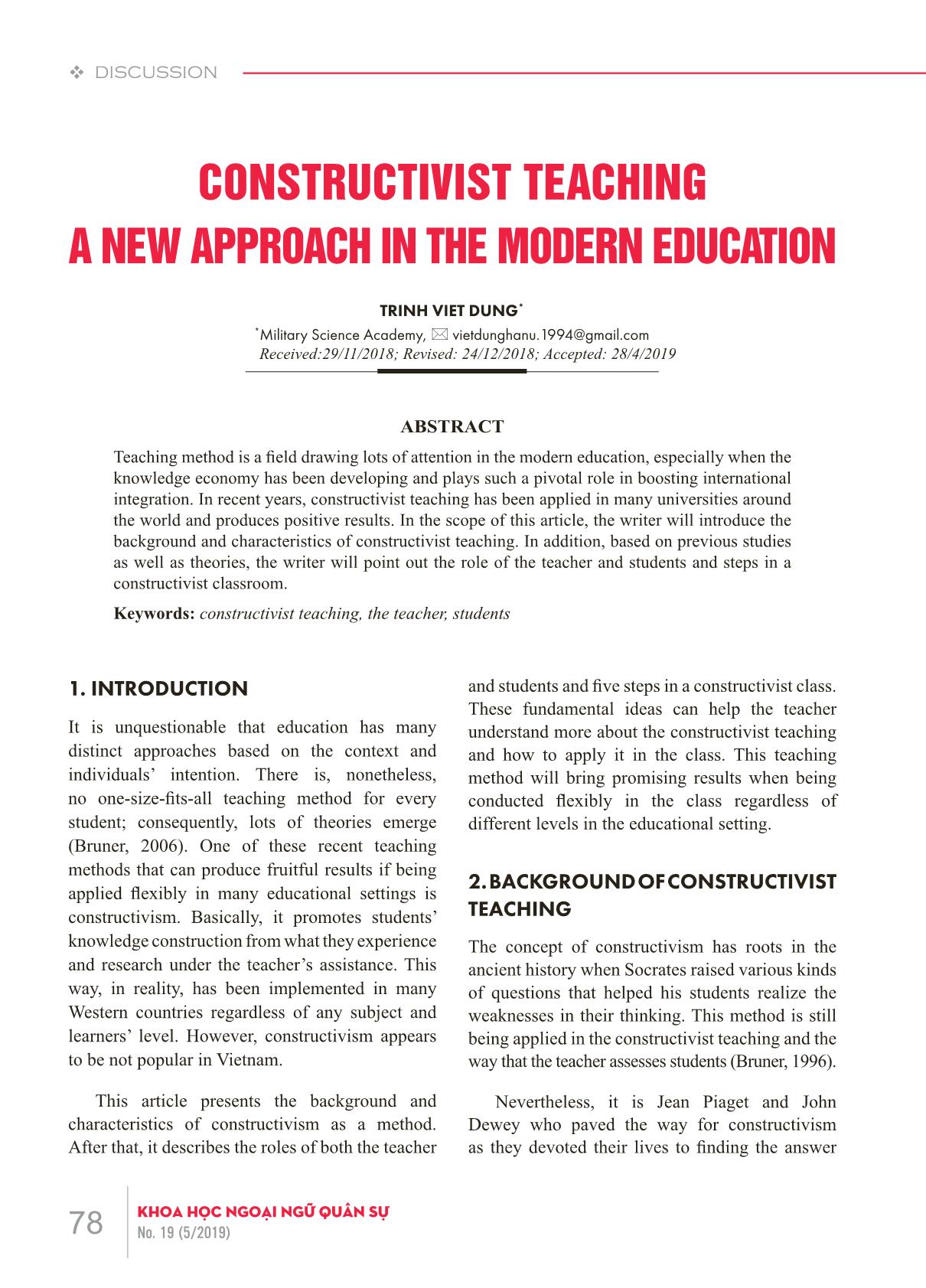
Trang 1
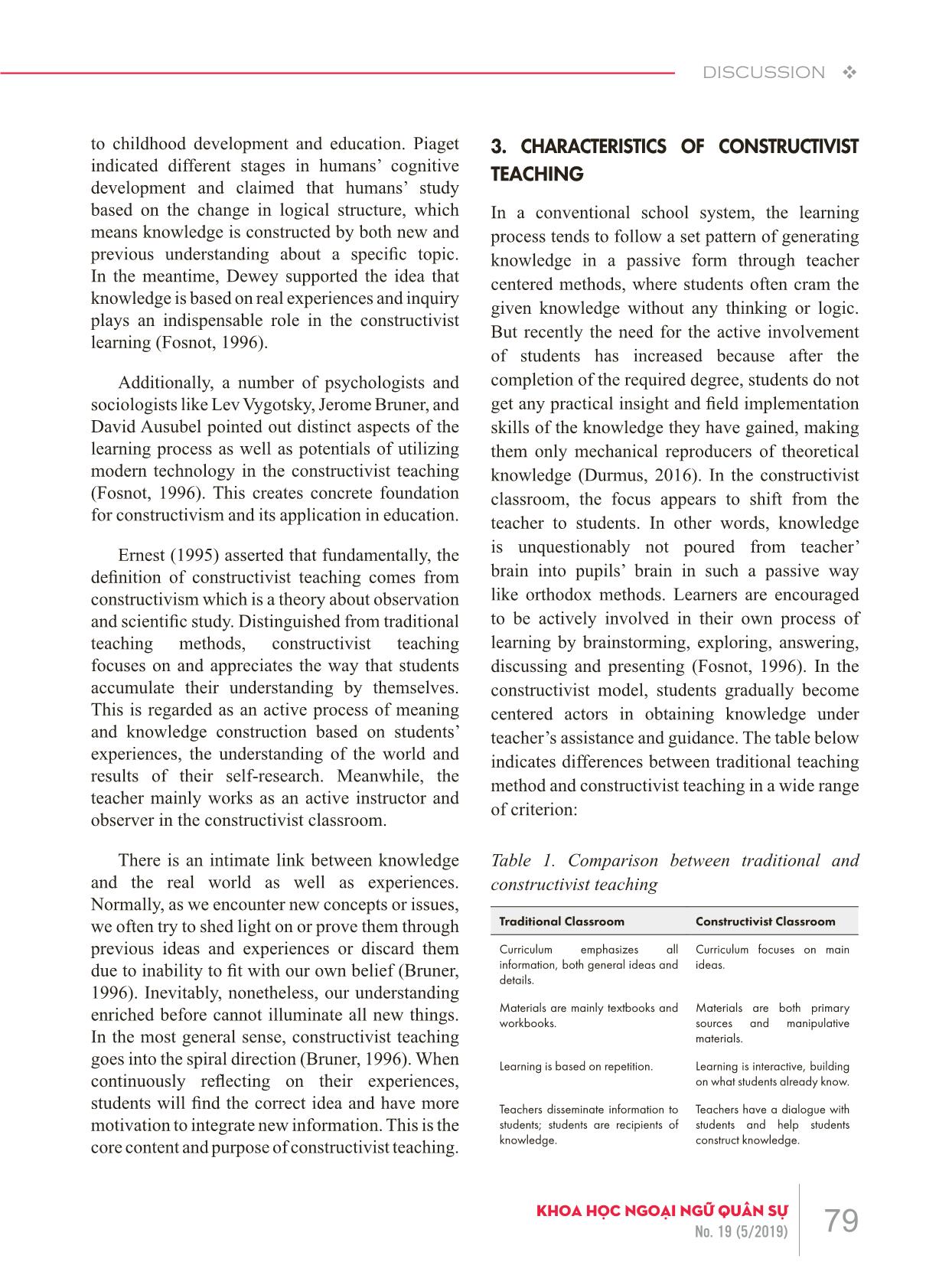
Trang 2
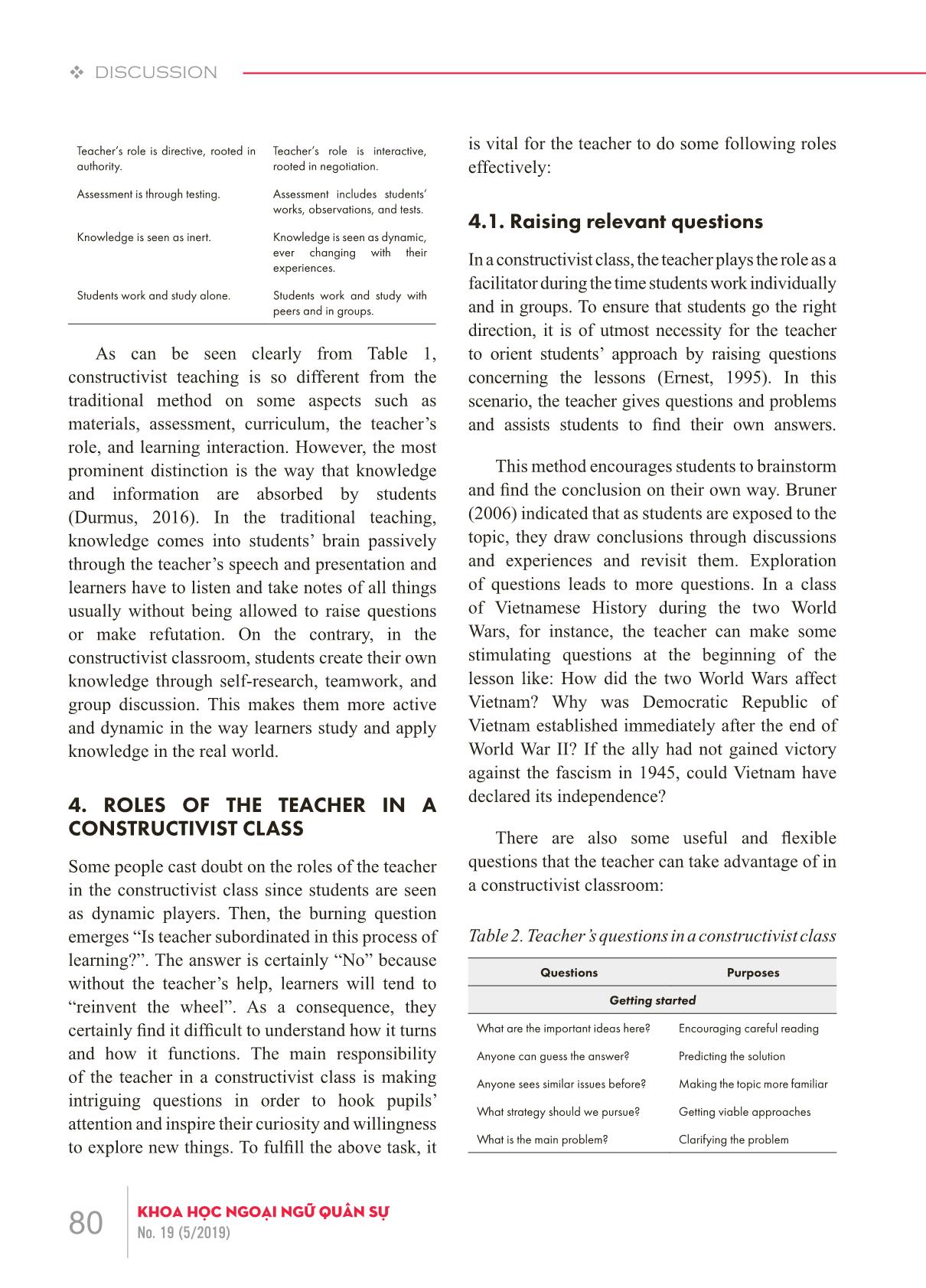
Trang 3
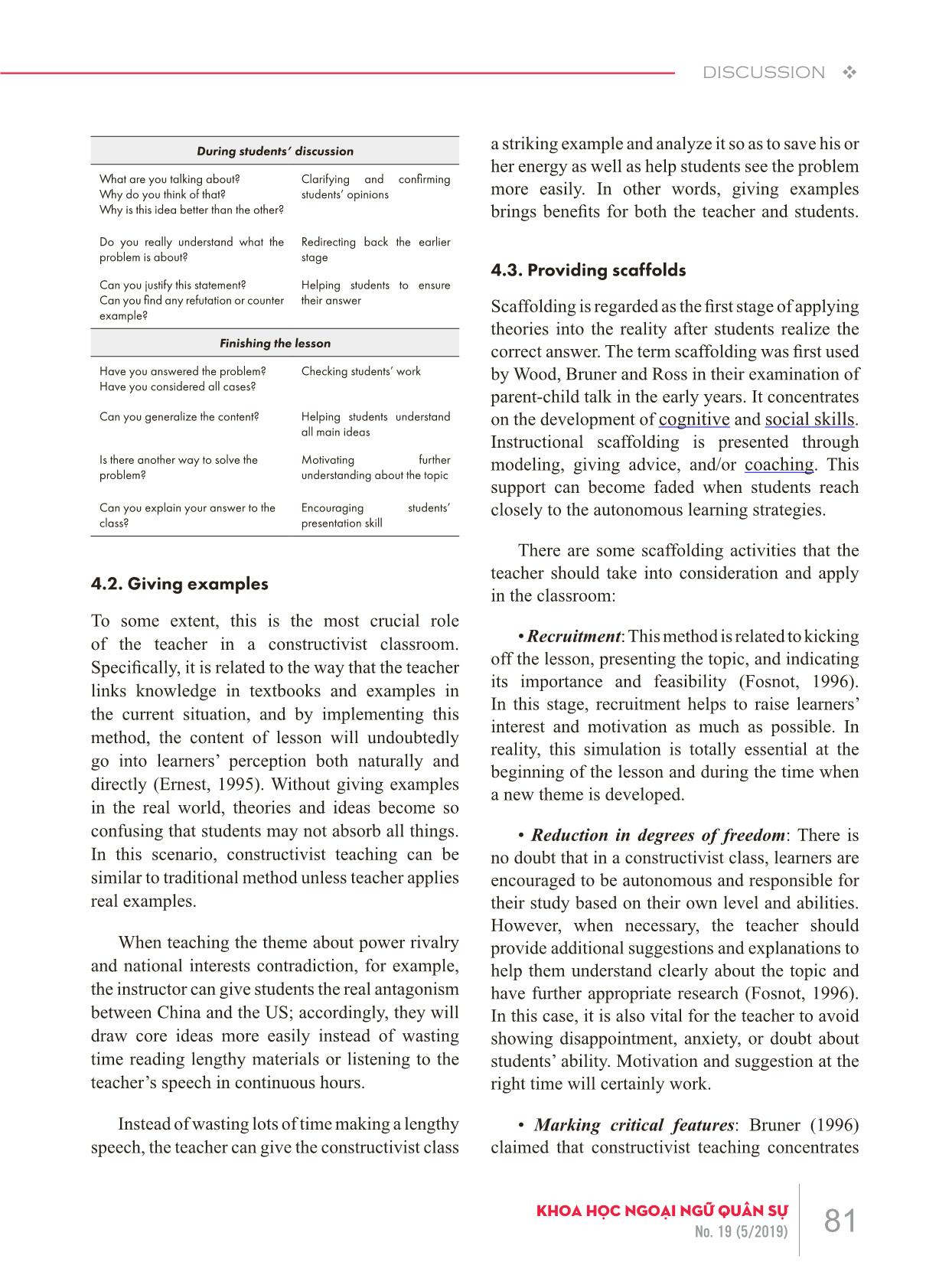
Trang 4
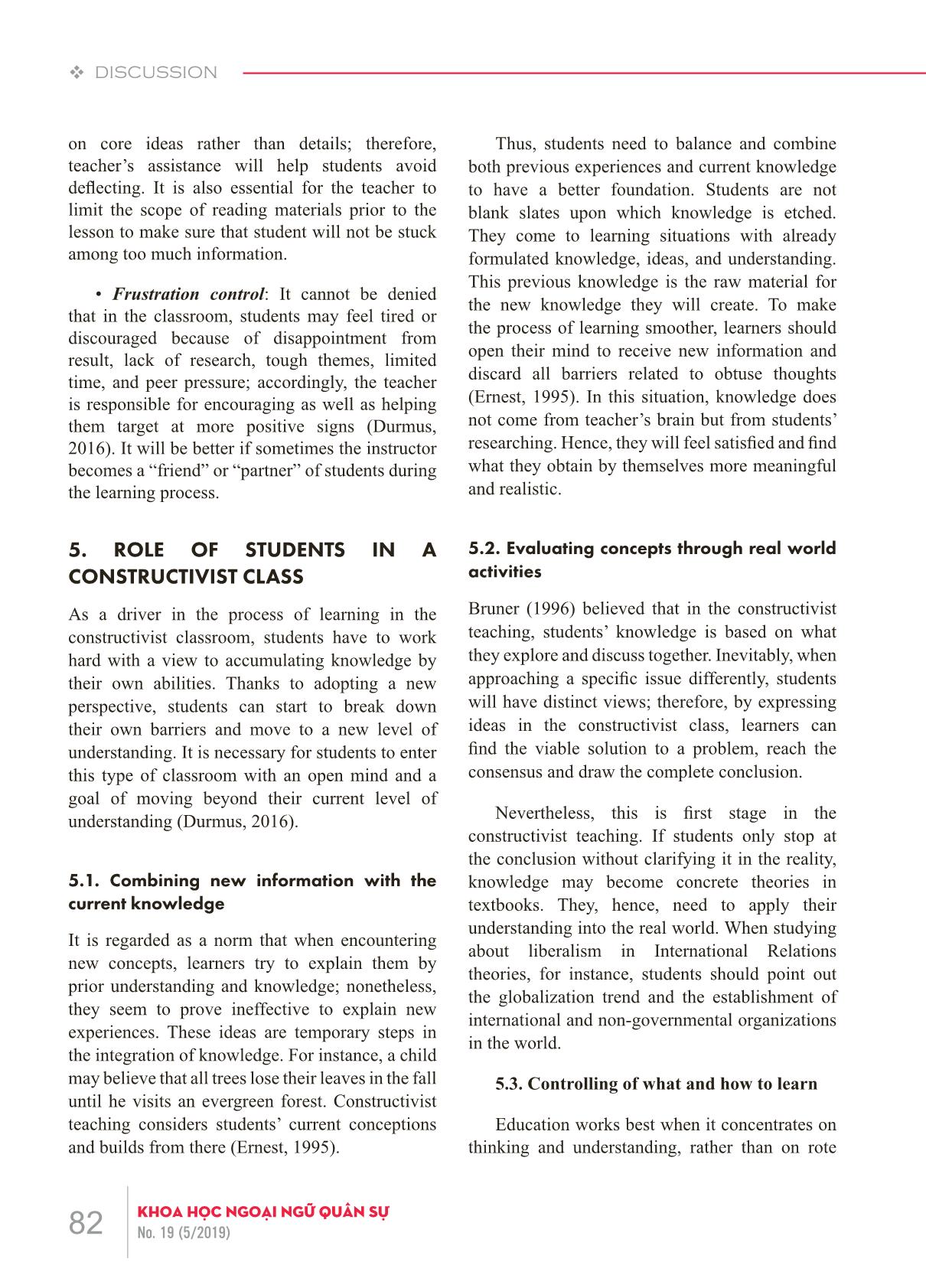
Trang 5
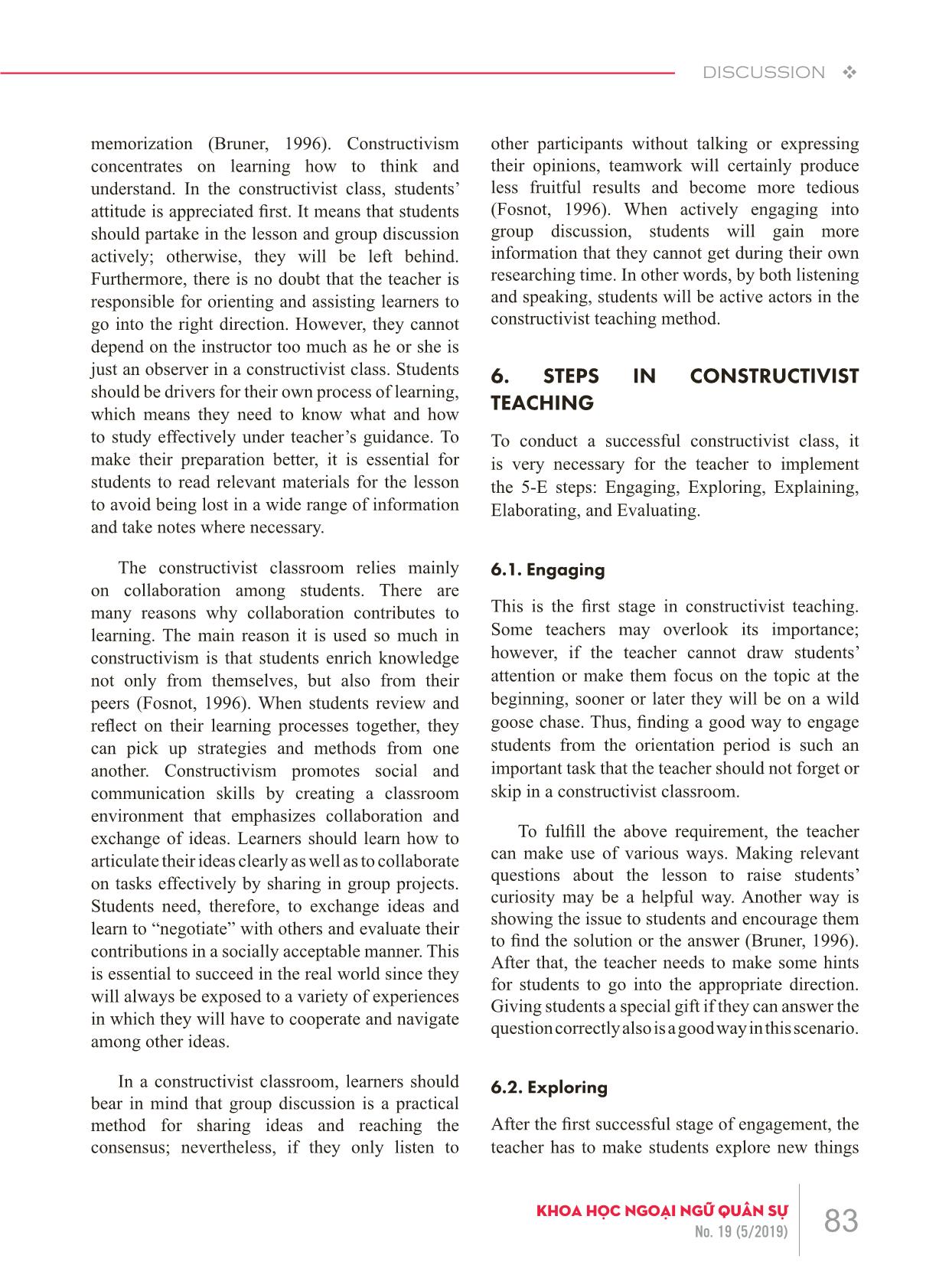
Trang 6
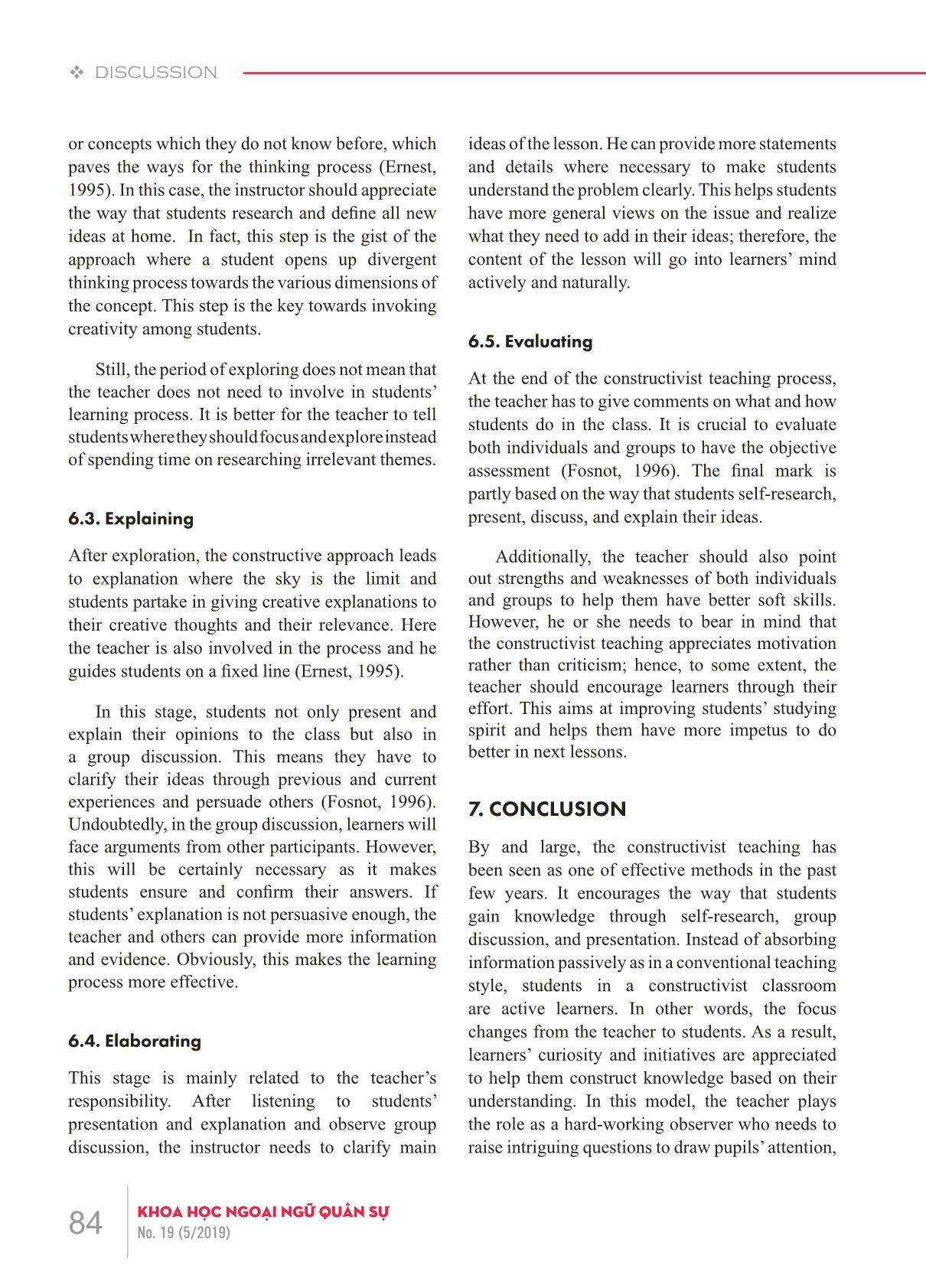
Trang 7
Bạn đang xem tài liệu "Constructivist teaching a new approach in the modern education", để tải tài liệu gốc về máy hãy click vào nút Download ở trên
Tóm tắt nội dung tài liệu: Constructivist teaching a new approach in the modern education
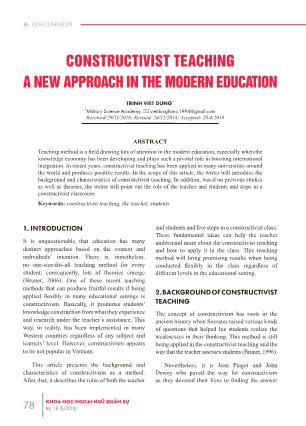
you considered all cases? Checking students’ work Can you generalize the content? Helping students understand all main ideas Is there another way to solve the problem? Motivating further understanding about the topic Can you explain your answer to the class? Encouraging students’ presentation skill 4.2. Giving examples To some extent, this is the most crucial role of the teacher in a constructivist classroom. Specifically, it is related to the way that the teacher links knowledge in textbooks and examples in the current situation, and by implementing this method, the content of lesson will undoubtedly go into learners’ perception both naturally and directly (Ernest, 1995). Without giving examples in the real world, theories and ideas become so confusing that students may not absorb all things. In this scenario, constructivist teaching can be similar to traditional method unless teacher applies real examples. When teaching the theme about power rivalry and national interests contradiction, for example, the instructor can give students the real antagonism between China and the US; accordingly, they will draw core ideas more easily instead of wasting time reading lengthy materials or listening to the teacher’s speech in continuous hours. Instead of wasting lots of time making a lengthy speech, the teacher can give the constructivist class a striking example and analyze it so as to save his or her energy as well as help students see the problem more easily. In other words, giving examples brings benefits for both the teacher and students. 4.3. Providing scaffolds Scaffolding is regarded as the first stage of applying theories into the reality after students realize the correct answer. The term scaffolding was first used by Wood, Bruner and Ross in their examination of parent-child talk in the early years. It concentrates on the development of cognitive and social skills. Instructional scaffolding is presented through modeling, giving advice, and/or coaching. This support can become faded when students reach closely to the autonomous learning strategies. There are some scaffolding activities that the teacher should take into consideration and apply in the classroom: • Recruitment: This method is related to kicking off the lesson, presenting the topic, and indicating its importance and feasibility (Fosnot, 1996). In this stage, recruitment helps to raise learners’ interest and motivation as much as possible. In reality, this simulation is totally essential at the beginning of the lesson and during the time when a new theme is developed. • Reduction in degrees of freedom: There is no doubt that in a constructivist class, learners are encouraged to be autonomous and responsible for their study based on their own level and abilities. However, when necessary, the teacher should provide additional suggestions and explanations to help them understand clearly about the topic and have further appropriate research (Fosnot, 1996). In this case, it is also vital for the teacher to avoid showing disappointment, anxiety, or doubt about students’ ability. Motivation and suggestion at the right time will certainly work. • Marking critical features: Bruner (1996) claimed that constructivist teaching concentrates 82 KHOA HỌC NGOẠI NGỮ QUÂN SỰNo. 19 (5/2019) v DISCUSSION on core ideas rather than details; therefore, teacher’s assistance will help students avoid deflecting. It is also essential for the teacher to limit the scope of reading materials prior to the lesson to make sure that student will not be stuck among too much information. • Frustration control: It cannot be denied that in the classroom, students may feel tired or discouraged because of disappointment from result, lack of research, tough themes, limited time, and peer pressure; accordingly, the teacher is responsible for encouraging as well as helping them target at more positive signs (Durmus, 2016). It will be better if sometimes the instructor becomes a “friend” or “partner” of students during the learning process. 5. ROLE OF STUDENTS IN A CONSTRUCTIVIST CLASS As a driver in the process of learning in the constructivist classroom, students have to work hard with a view to accumulating knowledge by their own abilities. Thanks to adopting a new perspective, students can start to break down their own barriers and move to a new level of understanding. It is necessary for students to enter this type of classroom with an open mind and a goal of moving beyond their current level of understanding (Durmus, 2016). 5.1. Combining new information with the current knowledge It is regarded as a norm that when encountering new concepts, learners try to explain them by prior understanding and knowledge; nonetheless, they seem to prove ineffective to explain new experiences. These ideas are temporary steps in the integration of knowledge. For instance, a child may believe that all trees lose their leaves in the fall until he visits an evergreen forest. Constructivist teaching considers students’ current conceptions and builds from there (Ernest, 1995). Thus, students need to balance and combine both previous experiences and current knowledge to have a better foundation. Students are not blank slates upon which knowledge is etched. They come to learning situations with already formulated knowledge, ideas, and understanding. This previous knowledge is the raw material for the new knowledge they will create. To make the process of learning smoother, learners should open their mind to receive new information and discard all barriers related to obtuse thoughts (Ernest, 1995). In this situation, knowledge does not come from teacher’s brain but from students’ researching. Hence, they will feel satisfied and find what they obtain by themselves more meaningful and realistic. 5.2. Evaluating concepts through real world activities Bruner (1996) believed that in the constructivist teaching, students’ knowledge is based on what they explore and discuss together. Inevitably, when approaching a specific issue differently, students will have distinct views; therefore, by expressing ideas in the constructivist class, learners can find the viable solution to a problem, reach the consensus and draw the complete conclusion. Nevertheless, this is first stage in the constructivist teaching. If students only stop at the conclusion without clarifying it in the reality, knowledge may become concrete theories in textbooks. They, hence, need to apply their understanding into the real world. When studying about liberalism in International Relations theories, for instance, students should point out the globalization trend and the establishment of international and non-governmental organizations in the world. 5.3. Controlling of what and how to learn Education works best when it concentrates on thinking and understanding, rather than on rote 83KHOA HỌC NGOẠI NGỮ QUÂN SỰNo. 19 (5/2019) DISCUSSION v memorization (Bruner, 1996). Constructivism concentrates on learning how to think and understand. In the constructivist class, students’ attitude is appreciated first. It means that students should partake in the lesson and group discussion actively; otherwise, they will be left behind. Furthermore, there is no doubt that the teacher is responsible for orienting and assisting learners to go into the right direction. However, they cannot depend on the instructor too much as he or she is just an observer in a constructivist class. Students should be drivers for their own process of learning, which means they need to know what and how to study effectively under teacher’s guidance. To make their preparation better, it is essential for students to read relevant materials for the lesson to avoid being lost in a wide range of information and take notes where necessary. The constructivist classroom relies mainly on collaboration among students. There are many reasons why collaboration contributes to learning. The main reason it is used so much in constructivism is that students enrich knowledge not only from themselves, but also from their peers (Fosnot, 1996). When students review and reflect on their learning processes together, they can pick up strategies and methods from one another. Constructivism promotes social and communication skills by creating a classroom environment that emphasizes collaboration and exchange of ideas. Learners should learn how to articulate their ideas clearly as well as to collaborate on tasks effectively by sharing in group projects. Students need, therefore, to exchange ideas and learn to “negotiate” with others and evaluate their contributions in a socially acceptable manner. This is essential to succeed in the real world since they will always be exposed to a variety of experiences in which they will have to cooperate and navigate among other ideas. In a constructivist classroom, learners should bear in mind that group discussion is a practical method for sharing ideas and reaching the consensus; nevertheless, if they only listen to other participants without talking or expressing their opinions, teamwork will certainly produce less fruitful results and become more tedious (Fosnot, 1996). When actively engaging into group discussion, students will gain more information that they cannot get during their own researching time. In other words, by both listening and speaking, students will be active actors in the constructivist teaching method. 6. STEPS IN CONSTRUCTIVIST TEACHING To conduct a successful constructivist class, it is very necessary for the teacher to implement the 5-E steps: Engaging, Exploring, Explaining, Elaborating, and Evaluating. 6.1. Engaging This is the first stage in constructivist teaching. Some teachers may overlook its importance; however, if the teacher cannot draw students’ attention or make them focus on the topic at the beginning, sooner or later they will be on a wild goose chase. Thus, finding a good way to engage students from the orientation period is such an important task that the teacher should not forget or skip in a constructivist classroom. To fulfill the above requirement, the teacher can make use of various ways. Making relevant questions about the lesson to raise students’ curiosity may be a helpful way. Another way is showing the issue to students and encourage them to find the solution or the answer (Bruner, 1996). After that, the teacher needs to make some hints for students to go into the appropriate direction. Giving students a special gift if they can answer the question correctly also is a good way in this scenario. 6.2. Exploring After the first successful stage of engagement, the teacher has to make students explore new things 84 KHOA HỌC NGOẠI NGỮ QUÂN SỰNo. 19 (5/2019) v DISCUSSION or concepts which they do not know before, which paves the ways for the thinking process (Ernest, 1995). In this case, the instructor should appreciate the way that students research and define all new ideas at home. In fact, this step is the gist of the approach where a student opens up divergent thinking process towards the various dimensions of the concept. This step is the key towards invoking creativity among students. Still, the period of exploring does not mean that the teacher does not need to involve in students’ learning process. It is better for the teacher to tell students where they should focus and explore instead of spending time on researching irrelevant themes. 6.3. Explaining After exploration, the constructive approach leads to explanation where the sky is the limit and students partake in giving creative explanations to their creative thoughts and their relevance. Here the teacher is also involved in the process and he guides students on a fixed line (Ernest, 1995). In this stage, students not only present and explain their opinions to the class but also in a group discussion. This means they have to clarify their ideas through previous and current experiences and persuade others (Fosnot, 1996). Undoubtedly, in the group discussion, learners will face arguments from other participants. However, this will be certainly necessary as it makes students ensure and confirm their answers. If students’ explanation is not persuasive enough, the teacher and others can provide more information and evidence. Obviously, this makes the learning process more effective. 6.4. Elaborating This stage is mainly related to the teacher’s responsibility. After listening to students’ presentation and explanation and observe group discussion, the instructor needs to clarify main ideas of the lesson. He can provide more statements and details where necessary to make students understand the problem clearly. This helps students have more general views on the issue and realize what they need to add in their ideas; therefore, the content of the lesson will go into learners’ mind actively and naturally. 6.5. Evaluating At the end of the constructivist teaching process, the teacher has to give comments on what and how students do in the class. It is crucial to evaluate both individuals and groups to have the objective assessment (Fosnot, 1996). The final mark is partly based on the way that students self-research, present, discuss, and explain their ideas. Additionally, the teacher should also point out strengths and weaknesses of both individuals and groups to help them have better soft skills. However, he or she needs to bear in mind that the constructivist teaching appreciates motivation rather than criticism; hence, to some extent, the teacher should encourage learners through their effort. This aims at improving students’ studying spirit and helps them have more impetus to do better in next lessons. 7. CONCLUSION By and large, the constructivist teaching has been seen as one of effective methods in the past few years. It encourages the way that students gain knowledge through self-research, group discussion, and presentation. Instead of absorbing information passively as in a conventional teaching style, students in a constructivist classroom are active learners. In other words, the focus changes from the teacher to students. As a result, learners’ curiosity and initiatives are appreciated to help them construct knowledge based on their understanding. In this model, the teacher plays the role as a hard-working observer who needs to raise intriguing questions to draw pupils’ attention,
File đính kèm:
 constructivist_teaching_a_new_approach_in_the_modern_educati.pdf
constructivist_teaching_a_new_approach_in_the_modern_educati.pdf

